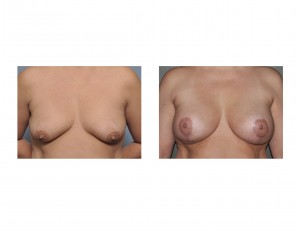Background: The combination of pregnancies, weight loss and gravity change most every woman’s breasts.All of these undesired changes are classic, the breasts change shape and they sag downward. The combination of more skin and less volume allows the breasts to lose their once uplifted and rounder appearance. Some women undergo involution only (breast tissue shrinkage)and develop no sag but this is not common.
The sagging breast may be able to be improved by implant augmentation alone but that depends on the degree of sagging. Only the most minimal of sagging can be improved by expanding the breast volume. If this is tried in more significant sagging, it not only is not improved but may actually become worse. For this reason, lifts need to be considered in many cases of breast reshaping regardless of whether implants are used or not.
Breast lifting can be accomplished by different types of lifts which are fundamentally differentiated by how much lifting they do and the length of scar they create. With the exception of the most minor degrees of sagging, only two types of breasts lifts really make a significant change. They are the vertical (lollipop) and combined vertical-horizontal (anchor) breast lifts which are so named based on their resultant scar patterns. Their degrees of lifting are impacted by the use of an implant and its size.



While the breast lift implant combination procedure is needed for many deflated and sagging breasts, it is not an easy operation in which to achieve optimal breast shape, symmetry and a centralized nipple position on the newly created mound. There are many challenges to achieving what most women expect to occur without incident. In reality, this breast reshaping operation has a high rate of the need for revisional surgery to correct implant position or size, the amount of lifting and tightening, a good areolar shape, or revision of wide scars. This patient was able to achieve her breast goals in a single procedure which is fortunate for her although not always common.
Case Highlights:
1) Breasts that have lost volume and sag after pregnancy need a combination of volume augmentation and a lift.
2) The placement of implants with a concurrent vertical lift (lollipop) provide adequate reshaping when the amounkt of breast sagging is mild to moderate. (nipple at or just below the lower breast fold)
3) Breast lifts with implants has a higher need for revisional surgery than when either procedure is performed alone.
Dr. Barry Eppley
Indianapolis, Indiana


